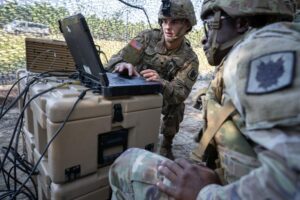The Army is beginning its pursuit for its eventual Unified Network program of record, soliciting industry’s input on capabilities that could support its effort to synchronize tactical and enterprise networking modernization efforts.
The Unified Network Operations (UNO) program will build off an ongoing rapid prototyping effort to inform the Army’s plan, according to a notice published on Feb. 16, to include areas such data repositories and new integrated network planning systems.

“The delivery of UNO capabilities to execute required Department of Defense Information Network operations functions will address their guidance to provide an available, reliable, and resilient network that commanders can employ as a weapons system in all operational environments against any adversary,” the Army wrote in the notice.
In October, the Army released its Unified Network plan which detailed a goal to transform the network from a “perceived invisible asset to a weapons system” by 2028 (Defense Daily, Oct. 8).
The Army’s Program Executive Office, Command, Control and Communications Tactical, Product Manager, Tactical Cyber and Network Operations (PdM TCNO) and Army Contracting Command, Aberdeen Proving Ground issued the new sources sought notice to begin assessing the capabilities that will set the foundation for the UNO program of record.
“This unified network will provide a seamless, integrated network management capability to simplify user experience, increase situational awareness, and strengthen cyber network defense. Under a unified network, communication officers (S6/G6) from the tactical edge through corps level will have fewer network management and monitoring applications and tools to manage, enhancing their ability to plan, configure, manage, monitor, and secure/defend the network,” the Army wrote in the notice.
In the lead-up to the UNO program of record receiving approval, the Army’s PdM TCNO has been running a rapid prototyping Mid-Tier Acquisition (MTA) program as a risk reduction effort to test potential solutions with soldiers in ongoing experimentations.
“The soldiers put the UNO capabilities through their paces in training and field exercises, and we incorporate their feedback to continually inform requirements,” the Army wrote. “This incremental development process enabled our team to evaluate new technology concepts and potential solutions earlier and more frequently, collect feedback in real time, and rapidly generate new requirements as needed.”
Technologies of interest that were part of the prototyping effort and future UNO plans include data repositories that serve as the main source of exchanging network operations data between disparate systems and a network operations management system to get after improved ability to monitor and operate tactical portions of the network.
The Army has also assessed requirements for an Application Programming Interface (API) and a new prototype called Atom that would replace the Army version of the Joint Enterprise Network Manager (JENM) software “for planning, managing, and monitoring of current and future tactical radios and waveforms in the lower tactical internet.”
“The UNO API capability will be designed to support the key Tactical UNO goal of reducing the workload on the Soldiers who use the network while enhancing their ability to better leverage the network as a warfighting platform,” the Army wrote. “This [Atom] prototype will be capable of operating on a variety of hardware platforms and operational domains, including ground, airborne and maritime.”
UNO prototyping efforts have also focused on unified planner solutions that would serve as “an integrated network planning system to integrate and/or replace existing network element planners” and software for monitoring and managing the new Integrated Tactical Network’s network components architecture, according to the Army.
Lt. Gen. John Morrison, the deputy chief of staff for the Army G-6, said in December the upcoming implementation plan for getting after the Unified Network construct will “assign responsible agents, [set] critical milestones and synchronize governance,” adding that critical tasks for the first 18 to 24 months will include figuring out how to best align enterprise and tactical network modernization priorities and expanding the classified network capability (Defense Daily, Dec. 14).